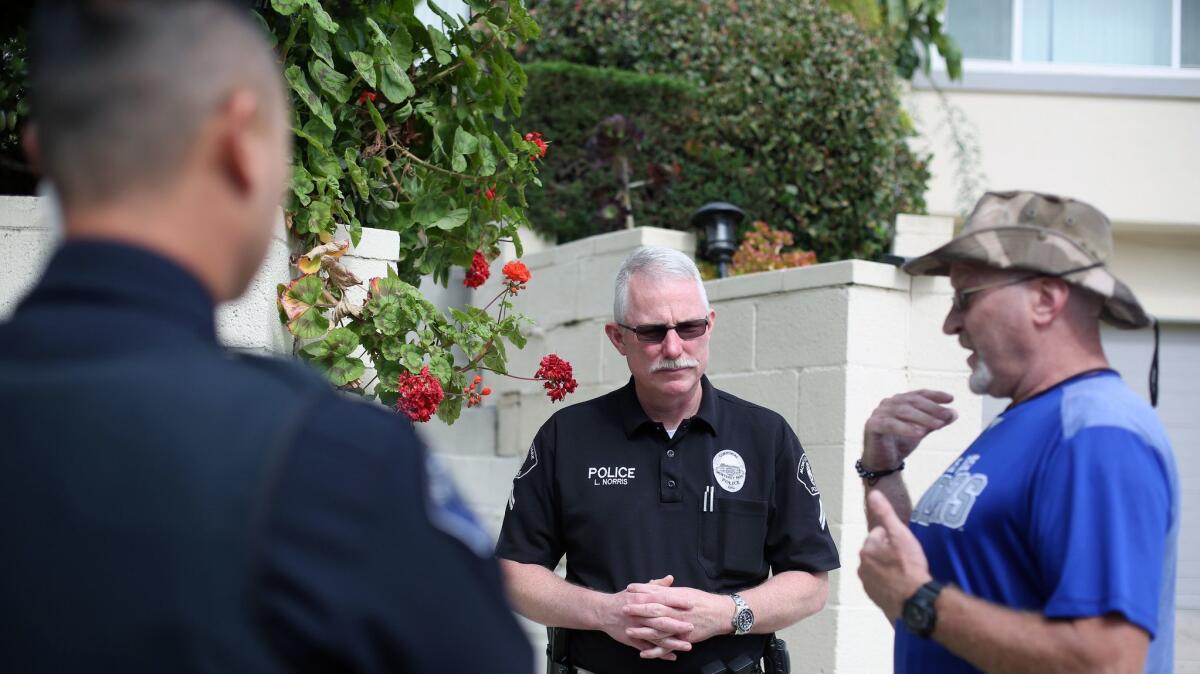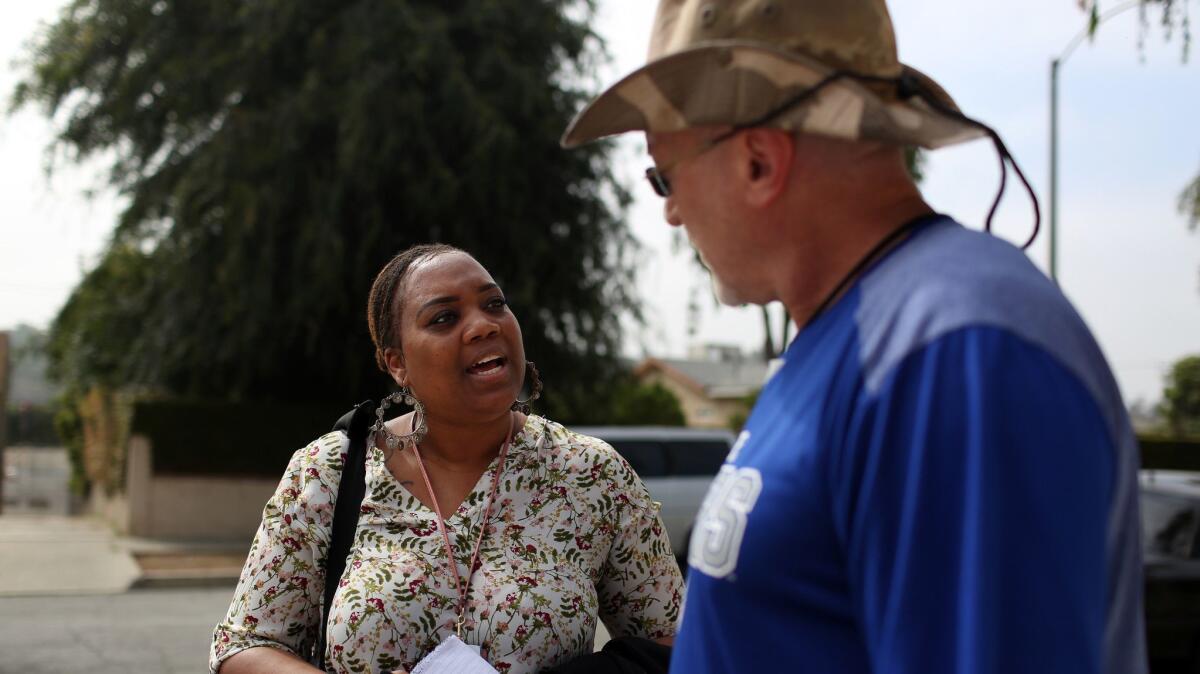Column: Police know the mentally ill need more than handcuffs. Their response is shifting

- Share via
The first time that Bob Hung had to handcuff his sister, in 2010, he was afraid.
He was just two years into his career as a patrol officer for the Monterey Park Police Department when his father called and told him that his older sister, diagnosed with schizophrenia, had run away from home. He called his supervisor and quickly shed his uniform.
On the long drive to his parents’ home in Rowland Heights, he imagined her being hit by a car. He thought about the time he had to run into traffic to tackle a mentally ill patient who had run away from a local hospital and worried that he wouldn’t be able to find her.
And even as a police officer who has had to use force on mentally ill suspects himself, even understanding that difficult choices must be made in seconds, he admits to another nagging fear: that police officers might use excessive force on his sister.
“Using force as an officer is not as simple as it looks,” said Hung. “But also from an officer’s perspective, anything could happen.”
Hung found his sister high up on a hill in a residential neighborhood overlooking Rowland Heights. He put the handcuffs on her, which seemed to calm her, and took her to the hospital, where she agreed to take medication. But it wouldn’t be the last time.
Police interactions with mentally ill people typically happen when everything else has failed. When therapy, counseling and education have been tried; when antipsychotic drugs lose their efficacy or patients stop taking them; when families can no longer manage the care of the patients themselves and relapses occur, somebody calls 911, and police officers respond.
It’s a situation with a well-documented risk of violence. More than one-third of the people shot by L.A. police officers in 2015 had documented signs of mental illness. And a Washington Post analysis of lethal police shootings in 2016 found that more than one-quarter of victims were mentally ill.
But the risk of violence also exists if the police are not called, in the form of injury to family members or caregivers who are attempting to manage a mental health crisis on their own.
Officers responding to a mental health call have to balance criminal law, patient rights, patient safety, their own safety, the safety of the patient’s family members. Police aren’t always the best people for the job, said Jim Smith, Monterey Park police chief and chairman of an L.A. County task force on mental illness and homelessness.
“There are much better people than us to respond. This is an issue that’s thrust upon us,” said Smith.
Mentally ill homeless people keep going to jail. But a study says L.A. County can fix that »
But Smith says there’s been a recent shift in the way police departments in Southern California police the mentally ill.
Over the last few years, governments have invested heavily in emergency mental health resources. Five mental health urgent care centers have been established across the county, with a sixth one coming to La Puente, Smith said. A dedicated psychiatric emergency response team now gives family members who are afraid to call police a number other than 911. And 39 teams across the county staffed with a police officer and a mental health professional act as “second responders” for cases involving mentally ill people.
“Having been involved in this issue for a lot of my career, I would have never thought I’d see so many resources,” said Smith, who credits Dist. Atty. Jackie Lacey for the reforms. “The troubling thing is that the number of calls we get are increasing.”
I recently accompanied Lee Norris, a Monterey Park police officer, and two employees from the Los Angeles County Department of Mental Health as they responded to mental health crises around Monterey Park.
At the first house we visited, a police cruiser was already parked out front.
An elderly woman lives there with a daughter who officials believe may be mentally ill. Neighbors have been complaining to police about paranoid, confrontational behavior for more than a year. And on a recent Saturday, when police responded to one of six 911 calls originating from their home, officers noticed a cut on the mother’s arm.
The daughter has made similar complaints about the neighbors to police, Norris said — she actually had called the police that morning.

Norris and Tina Webb, a clinician from DMH, knock on the door with the goal of trying to convince the daughter to get evaluated and receive care.
If that fails, then they’ll try to establish whether she is a danger to herself and others, and grievously disabled. If she meets the criteria, they can write what’s called a 5150 hold, a legal classification that allows them to force her to get evaluated and potentially get her into care.
But the daughter does not believe she is mentally ill. She has learned what words to say to prevent officers and clinicians from declaring a 5150 hold and repeats them. She refuses to talk about the cut on her mother’s arm, saying only that they have argued often since her father died recently.
After checking for signs of violence in the house and speaking to the mother to make sure she is safe, everyone leaves. Sometimes there’s nothing else to do.
“There are much better people than us to respond. This is an issue that’s thrust upon us.”
— Jim Smith, Monterey Park police chief
“You kind of have to take baby steps,” said Juan Aguirre, the other DMH employee. “Keep building trust, keep doing what you say you’re going to do, at the end hopefully we’ll have some success stories.”
On each call, Norris makes sure to encourage family members of mentally ill people to call the police if they feel unsafe. He teaches a 16-hour mental illness training for first responders, where his goal is destigmatizing mental illness and changing the culture of policing, Norris said.
That means things like confronting officers who use disrespectful slang terms for the mentally ill on the radio; teaching patrol officers that raising their voices at noncompliant people who have schizophrenia will probably make things worse; and encouraging supervisors to budget more time for emergency responses involving mental health crises. One training activity involves placing a bag over a police officer’s head to help them understand the symptoms of schizophrenia.

The collaborative responses have allowed law enforcement and mental health professionals to educate one another, Webb said. And because they follow up after the initial emergency call, they’ve been able to get people into care.
At the next house, Josephine Reyes, 64, answers the door.
Her son, who is schizophrenic, has been homeless and sleeping in a car, and recently reentered the home. Norris came to check on Reyes’ safety because her son has gotten violent with her in the past.
In high school, Reyes’ son was a popular student and the captain of the water polo team. But in college he started to have “strange thoughts,” failed classes and was later diagnosed with schizophrenia, Reyes said.
He has gone off and on his medications over the years because antipsychotic drugs can cause excessive weight gain and emotional swings. He managed to get a job at a grocery store last year when he went off his medications, but the stress from not taking his medications caused a relapse.
Reyes is still hoping that his condition improves, but if not, she’s grown comfortable with the idea of calling the police when she feels unsafe.
“God is in control. That’s just my belief,” she said.
The last time that Hung had to handcuff his sister, a few years ago, he wasn’t afraid anymore.
Now a corporal supervising patrol officers, with years of experience responding to mental health crises, he got the same call from his father as in 2010 — his sister had run away again.
He drove to Rowland Heights, where officers had responded to Wilson High School and restrained his sister out front. When she tried to get away, he had to take her down himself. Eventually he convinced his sister to get in his car and drove her to a hospital. It’s almost routine at this point — he knows how best to approach his sister, and to which hospital she likes him to take her. They’ve talked about it together.
Hung first began to suspect his sister was sick when he was in high school and she was studying English at UC Berkeley. On their weekly phone chats, she’d complain that professors were following her around.
She started to fail her classes and came home. The family took the news of the diagnosis hard — she was the most responsible sibling, the hardest worker, the kindest one. She always gave Hung spending money from her wages at her job at a Chinese bakery, and she volunteered at animal shelters and the local Buddhist temple in her spare time. She was studying to be a speech pathologist.
It was especially difficult for everyone to let go of the idea that she might get better — schizophrenia has no cure, though it can be successfully treated and managed. But over the years the family has learned to treasure small victories, like when she feels good enough to accompany them on trips to Costco and goes on hikes with her dad. Everyone rejoiced when she completed her UC Berkeley degree with additional coursework from a local college.
His mother still worries about his sister, so Hung and his brother promised that they would always take care of her.
They bought homes close to their parents’ house in Rowland Heights so they would always be around to help. And both sons made sure to buy properties large enough to construct a back house for their sister, so she will always have a home.
More to Read
Sign up for Essential California
The most important California stories and recommendations in your inbox every morning.
You may occasionally receive promotional content from the Los Angeles Times.













